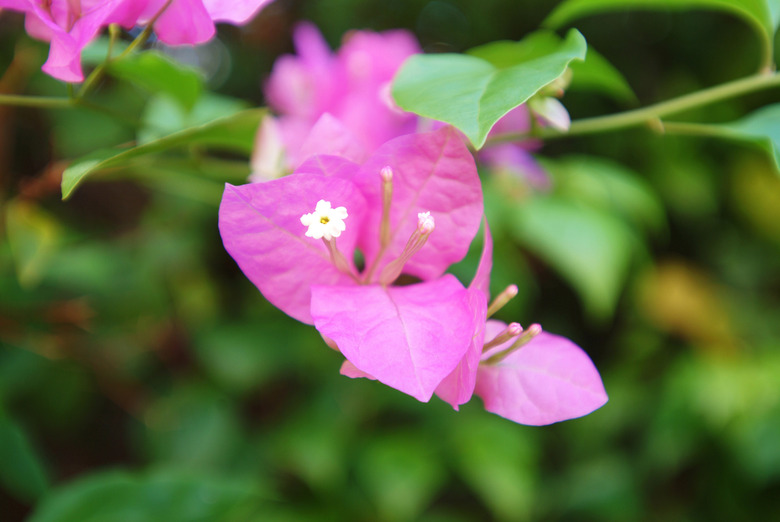Bougainvillea Leaf Curl
Bougainvillea (Bougainvillea spp.), also called paper flower, is a group of flowering plant species native to South America. These tropical plants have showy flowers and evergreen leaves, which make them an attractive choice for landscaping projects in tropical and semitropical climates. Under ideal conditions, bougainvillea leaves remain healthy and vibrant year-round. However, there are several factors that damage these plants' foliage, discoloring and curling the leaves.
Pests
Pests
Several insect pests attack bougainvillea leaves, which results in leaf curling and wilting. The bougainvillea looper (Disclisioprocta stellata) is a nocturnal caterpillar with a green or brown body. It consumes the edges of leaves, causing them to gradually curl inwards as the damaged tissue rots away. According to a University of Hawaii Extension publication, these pests attack all bougainvillea and have a large natural range that extends throughout tropical climates in both North and South America. Aphids are also associated with leaf curling in bougainvillea. Swarms of these tiny insects suck sap directly from the plant's foliage, which causes them to become rigid and curl inward.
Diseases
Diseases
Leaf curling is a common symptom of many plant diseases, including infections of both fungal and bacterial pathogens. The Pseudomonas andropogonis bacteria and by several genera of fungi cause leaf spot disease. Initial symptoms include discolored patches on the foliage's surface, followed by withering and disfigurement. Fungal leaf spot affects most plants and is usually managed by pruning infected leaves and removing plant debris several times a year. Root rot caused by Rhizoctonia fungi and other species are among the more serious diseases that cause the leaves of bougainvillea to curl. Damage to the root system prevents the plant from absorbing water and nutrients from the soil, effectively strangling the green growth above the soil line. Yellowed and curling leaves are one of the first visible symptoms of these infections.
Soil Quality
Soil Quality
The soil's composition and texture can also lead to curling and discolored leaves in bougainvillea. Heavy soil types, like those with high clay content, often hold too much water near the roots of plants. This stifles the root system, which damages the leaves and flowers. Insufficient moisture causes the plant's leaves to turn brown and wilt. A soil test reveals mineral or nutrient deficiencies in potting or growing soil, which may also cause deformities or diminished growth of leaves. Bougainvillea also prefers a slightly acidic pH level, between 5.5 and 6.0. Alkaline pH above 7.0 or excessively acidic environments can prevent the plant from absorbing certain minerals from the soil.
Environmental Conditions
Environmental Conditions
Harsh environmental conditions, particularly low temperatures, can harm bougainvillea. They thrive in full sunlight, but perform poorly in partial or full shade. Insufficient light may prevent the plant from conducting photosynthesis, which causes the leaves to lose vibrancy and begin to curl. According to a University of Hawaii publication, these plants should be kept at a minimum temperature of 64 to 68 degrees Fahrenheit. Exposure to lower temperatures, even for a short time, may damage the plant or hinder a bougainvillea's growth.
